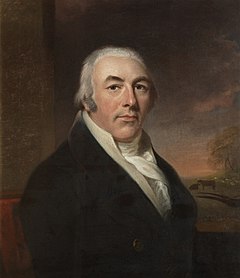John Billingsley (agriculturist)
| John Billingsley | |
|---|---|

Painting of John Billingsley (1747–1811) painted by Joseph Hutchinson (1747–1830). Oil on canvas, 63.5 x 53.4 cm
|
|
| Born | 1747 Ashwick, Somerset |
| Died | 26 September 1811 Ashwick, Somerset |
| Nationality | British |
| Occupation | Agricultural pioneer |
| Known for | 1795 survey of agriculture in Somerset |
John Billingsley (1747–1811) was an agricultural pioneer in 18th century Somerset, England.
The writer of the 1794 Survey of Somerset, Billingsley was a leading agriculturalist who was one of the founders of the Bath and West Society, known today as the Royal Bath and West of England Society. He lived all his life at Ashwick Grove.
He was born in 1747, the grandson of Nicholas Billingsley, a Presbyterian dissenter who was minister at Ashwick from 1699 to 1729. Little is known about his early life but by 1782 he was listed as Brewer along with Ryan Gosling of the Oakhill Brewery in the neighbouring village of Oakhill, and may have been involved in the wool trade before that.
He was described as a leading member of the Presbyterian church although at some stage he was reconciled with the Church of England.
The 18th century was largely one of peace in Somerset, but the Industrial Revolution in the Midlands and Northern England spelled the end for most of Somerset's cottage industries. Farming continued to flourish however, with Billingsley farming about 4,000 acres (16 km2), and the Bath and West of England Society for the Encouragement of Agriculture, Arts, Manufactures and Commerce was founded in 1777 to improve farming methods. Despite this, 20 years later John Billingsley conducted a survey, for the Board of Agriculture, of the county's agriculture in 1795 and found that agricultural methods could still be improved. He provided estimates, based on his local knowledge, of the land use of the one million acres (4,000 km2) in the county. He suggested that 584,500 were enclosed meadow and pasture land, 260,000 were enclosed arable and convertible land with smaller areas for other purposes. 65,000 acres (260 km2) were considered uncultivated wastes.
...
Wikipedia
